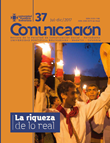Healthy lifestyles and mass media: analysis on pregnant women in high complexity health institution in Medellín
Main Article Content
Abstract
Objective: To characterize the pregnant women in the formation of healthy living habits, in relation to communication media and health personnel as sources of information. Methods: A cross-sectional study was conducted in postpartum women attended in a highly complex institution. Sociodemographic variables of interest were included in relation to the contribution of the media in the change of health care habits and lifestyles. An exploratory bivariate analysis was performed, with OR calculation and 95% confidence intervals. Results: 49% of the surveyed women considered the importance of the media on the perceived healthy habits during pregnancy, in relation to the feeding and care of the baby. Approximately 95% said they understood the instructions given by the health personnel. The associations between some sociodemographic variables (area of residence, marital status and level of schooling) were significant with the perception of the importance or contribution of the media and their possible influence on the care habits and lifestyles of the pregnant women. Conclusions: it is necessary to go deeply on analytical investigations to demonstrate the influence of the media on habits during pregnancy. It is necessary the participation of health personnel in the dissemination of information related to the care and development of pregnancy, through means such as the Internet and mobile telephony, which involve sociodemographic characteristics such as level of studies and occupation.
References
Bandura, A. (1973). Agression: A Social learning analysis. Nueva Jersey: Englewood Cliffs Prentice.
Bandura, A. (1982). Teoría del aprendizaje social. Madrid: Espasa-Calpe.
Busdiecker, S., Castillo, C., y Salas, I. (2000). Cambios en los hábitos de alimentación durante la infancia: una visión antropológica. Revista Chilena de Pediatría, 71(1), 5-11.
Cheney, G. (2000). Interpreting interpretive research. Toward perspectivism without relativism. En S. R. Corman y M. S. Poole (Eds.), Perspectives on organizational communication. Finding common ground (pp. 17-45). Nueva York: Guilford.
Dever, G. (1977). Epidemiological Model for Health Policy Analysis. Social Indicators Research, (2), 453-466.
Díaz, H., y Uranga, W. (2011). Comunicación para la salud en clave cultural y comunitaria. Revista de Comunicación y Salud, 1(1), 113-124.
Dutta-Bergman, M. (2004). Reaching unhealthy eaters: Applying a strategic approach to media vehicle choice. Health Communication, 16, 493-506.
Fineberg, H. V. (1988). The social dimensions of AIDS. Emmitsburgo: National Emergency Training Center.
Gallardo, L. (2012). Los programas para el cambio de comportamientos sociales como praxis comunicativa: una visión del Marketing Social desde la Comunicación. Questión, 1(34), 131-142.
Giraldo, A., Toro, M. Y., Macías, A. M., Valencia, C. A., y Palacio, S. (2010). La promoción de la salud como estrategia para el fomento de estilos de vida saludables. Revista Hacia la Promoción de la Salud, 15(1), 128-143. Recuperado de http://www.redalyc.org/ pdf/3091/309126693010.pdf
Islas-Carmona, J. O. (2008). El prosumidor. El agente comunicativo de la sociedad de la ubicuidad. Palabra Clave, 11(1), 29-39. Recuperado de http://www.redalyc.org/articulo. oa?id=64911103
Klaper, J. (1974). Efectos de las comunicaciones. Madrid: Aguilar. ONUSIDA (2001). Informe mundial sobre la epidemia VIH/SIDA de diciembre de 2001 Ginebra: ONUSIDA y OMS. Recuperado de http://data.unaids.org/Publications/IRC-pub06/ epiupdate01_es.pdf
Organización Panamericana de la Salud (2001). Manual de comunicación social para programas de promoción de la salud de adolescentes. Washington: Fundación W. K. Kellogg. Recuperado de http://www1.paho.org/Spanish/HPP/HPF/ADOL/ComSocial.pdf
Programa de las Naciones Unidas para el Desarrollo (PNUD) (2015). Objetivos del Desarrollo del Milenio Colombia - Informe 2015. Colombia: Programa de las Naciones Unidas Para el Desarrollo. Recuperado de http://www.co.undp.org/content/colombia/es/home/ library/mdg/informe-de-2015-sobre-los-objetivos-de-desarrollo-del-milenio.html
Ríos, I. (2011). Comunicación en salud: conceptos y modelos teóricos. Perspectivas de la Comunicación, 1(4), 123-140.
Robertson, T. (1971). Innovate behavior and communication. Londres: Holt, Rinehart and Winston





